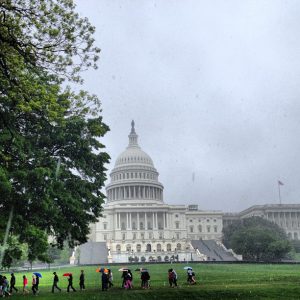
Photo courtesy of Architect of the Capitol
Several significant bills that would benefit stormwater infrastructure investments and management are moving through the U.S. House of Representatives and U.S. Senate. More concern by Congress to avoid overburdening ratepayers about community challenges to meet water infrastructure investments has led to growing support for integrated planning. Stormwater investment in particular can be hampered by limited funding resources and competing water infrastructure needs to meet regulatory obligation.
In the Senate
In the Senate, S. 692, the Water Infrastructure Flexibility Act, passed out of the Senate Environment & Public Works Committee on April 5, 2017. The bill now is awaiting time on the Senate flood calendar. The bill is bi-partisan and is very like language passed by the Senate as part of the 2016 Water Resources Development Act.
The bill will codify into federal law the use of integrated planning and direct the U.S. Environmental Protection Agency (EPA) to revise its guidance on affordability so that median household income is not the sole factor when regulators and utilities are determining the capabilities of communities to make infrastructure investments. The bill also directs EPA to “promote the use of green infrastructure in and coordinate the integration of green infrastructure into, permitting programs, planning efforts, research, technical assistance, and funding guidance.”
Finally, EPA would be directed to establish an Office of Municipal Ombudsman to provide technical assistance to communities for compliance to the Clean Water Act and Safe Drinking Water Act.
In the House
In the House there are three bills on integrated planning that are garnering attention. H.R. 465, the Water Quality Improvement Act by Rep. Gibbs (R-OH), was developed last year while he what the chairman of the House Water Resources Subcommittee. The bill has many similarities to S. 692, but also includes the creation of a pilot program that will aid 15 communities in the implementation of voluntary integrated plans.
Also in the House, H.R. 2355, is one of two companion bills to the Water Infrastructure Flexibility Act in the Senate and has strong bi-partisan support. The other companion bill is H.R. 1971, and the bill texts are nearly identical.
No legislative action has been taken yet for any of the bills in the House, but the House Water Resources Subcommittee held a hearing on May 18, 2017, on integrated planning, which could be a precursor to a mark-up soon.
Simultaneous efforts
Additionally, two larger bi-partisan water infrastructure funding bills were introduced recently in the House and Senate. Both will authorize significant funding for stormwater projects. S. 1137, the Clean, Safe, Reliable Water Infrastructure Act, will reauthorize Section 221 of the Clean Water Act, which provides grants for addressing combined sewer overflows, sanitary sewer overflows, and stormwater discharges, totaling $1.8 billion over 5 years. H.R. 2510, the Water Quality Protection and Job Creation Act, reauthorizes Section 221 at $2.5 billion over 5 years, as well as creates a pilot program to provide $600 million over 5 years to promote stormwater best management practices at a watershed or system-wide level.
If passed, the differences in these bills would be resolved in a conference committee.
Why these bills matter
Beyond allocating funding to stormwater projects, these bills also reflect a move toward integrated planning as a voluntary and encouraged method of business. Existing federal policy allows for communities to develop an integrated plan with state and federal regulators that allow for communities to prioritize their infrastructure investments while not overburdening ratepayers.
Many integrated plans are developed through court-approved consent decrees. However, federal policy allows for plans to be developed voluntarily between communities, federal regulators, and state agencies. Unfortunately, voluntary plans are few and far between. So, these bills pending in Congress intend to encourage and incentivize the development of voluntary integrated plans.
















It was really interesting how you said that because stormwater monitoring and processing has become bigger, the government is starting to look into it. Getting the government onboard a project is always good because they have funds and access to scientists and researchers and stuff. That would mean that experiments and projects would move much quicker and be done with a greater quality as well.
https://waterwatchpro.com/features